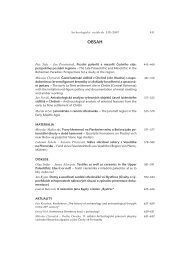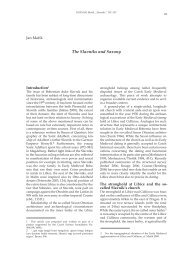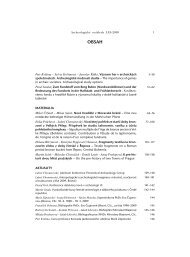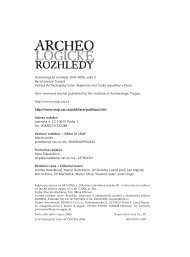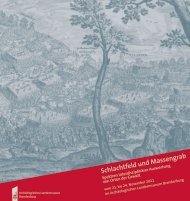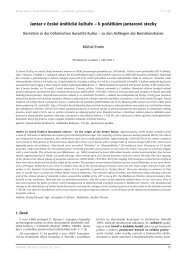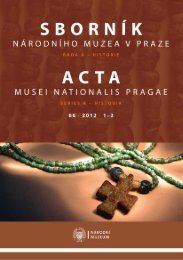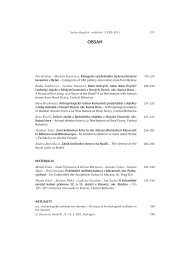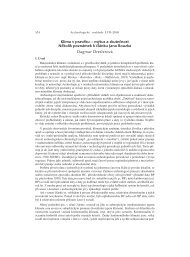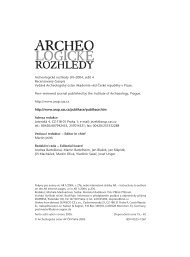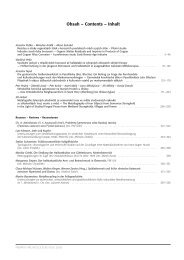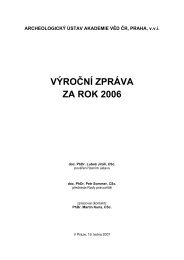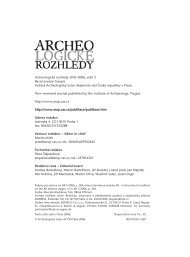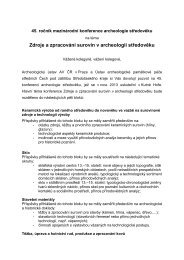Create successful ePaper yourself
Turn your PDF publications into a flip-book with our unique Google optimized e-Paper software.
Archeologické rozhledy LX–<strong>2008</strong> 259The presented work offers commented results of carpological and xylotomical analyses of 61 samplesin total, found in the sump E. This sump was much richer in vegetal remains (also in artefacts) thanthe sump B of the same age, explored before (Dohnal 1986; 1987). At the time when this couple ofsumps was in function, all refuse from the hospital was collected in the yard covered with gravel.Also refuse from two flats of the employees of the Prague Castle and from the neighbouring house inwhich a Spanish envoy was living till 1610 was collected there. Perhaps latrine enclosures used to standover the cesspits (latrine board, stinking contents inside). Pollen analysis has not been performed.The material was flushed in a standard manner through a 0.5 mm mesh screen; vegetal remainswere dried up, separated and determined by means of stereo magnifying glass. Approximately29 800 diasporas + 5000 fragments of seeds, fruits, wood and charcoal were obtained (refer to tab. 1).As much as 60 % of the total number of taxa was utility plants. Compared with medieval finds in Pragueand in the Czech Republic, a large share of spices and medicinal plants was noticeable. This factcorresponds well with the finds of little glass bottles and small stoneware containers for medicamentsand pharmaceuticals, evident requisites of the hospital. Foodstuff remains – especially those of fruit,spices, less frequently occurring species of vegetable, oil plants and cereal plants – bear relation tothe finds of kitchen things (spoons, forks, pots, lids, dishes, jugs, beakers, etc.) including a preciousdish for rice of Chinese origin, from the time of the dynasty Qing. The wildly growing ruderalspecies, weeds and plants typical for damp meadows, as we have them in Prague repeatedly documentedfrom the Malá Strana/Lesser Town (Čulíková 1998; 2001), were markedly less representedhere. Evidently, the yard was closed, without a direct access for the ruderal species.High employment of cultivated species (fruit, oil plants, spices, vegetables, cereals) as well asemployment of numerous wild species in home healing as well as in official medicine should besupposed in the Renaissance period, the same as during the Middle Ages. Approximately 100 taxawith a possible function of a drug were present. The properties of rustic tobacco (fig. 1), the circumstancesof the find of its seed, first in the sump in Kanovnická Str., later on at the nearby Hradčanskénám./Sq. (Čulíková 2007) indicate that tobacco had rather the function of a medicinal plant thanthat of a smoking material in spite of the fact that remnants of pipes were found in the sump. It ispossible that tobacco was cultivated in the nearby Royal botanical garden or even in the area ofHradčany. Many species of utility plants were common for both the mentioned sites within theHradčany area.Aregular occurrence of numerous macerated leaves (in total 68 + 41 fragments) of common box(Buxus sempervirens – fig. 5) in as much as one third of the studied samples was another remarkablefind. Their presence in the object of the hospital, medicinal properties of the bark and especially ofthe leaves employed till today (at healing of gout, rheumatisms, syphilis, dermal diseases) whichwere elaborated and commented already in the Czech translation of the Matthioli’s herbal (1596),indicate the possibility that this woody plant was introduced into Bohemia already before 1835 (cf.Koblížek 1992) and was already successfully cultivated in the Renaissance Prague, at the time whenthe sump was filled. Of course, the pollen has not been found so far in the anthropogenic sedimentsin the Czech Republic hence neither import (of plants or extract?) from Southern Europe can be excluded.From the imports, in addition to tobacco, it was rice (Oryza sativa – fig. 4) that was also presentin Kanovnická Street. So far, rice is registered in the territory of the Czech Republic since the 14 thcentury (Kühn 1995) but even the finds from the early Modern Era are not frequent here. Evidentlyalso fig-tree (Ficus carica – more than 4000 seeds) is an import. In our country a limited quantityof it was cultivated in fig-tree gardens and orangeries.From the species introduced into Bohemia during the height of the Middle Ages it was sugarymelon (Cucumis melo) and very soon, in the 16 th century, it was common pumpkin (Cucurbita pepo –fig. 3). The former finds of pumpkin seeds in our country were known only from two sites situatedwithin the area of Prague (Holý 1972; Opravil 1994) and from Southern Moravia (Opravil 1985).It cannot be determined from the finds whether the found fruits of coriander (Coriandrum sativum)and those of fennel (Foeniculum vulgare) were produced in Bohemia (Prague) or if also these mean



